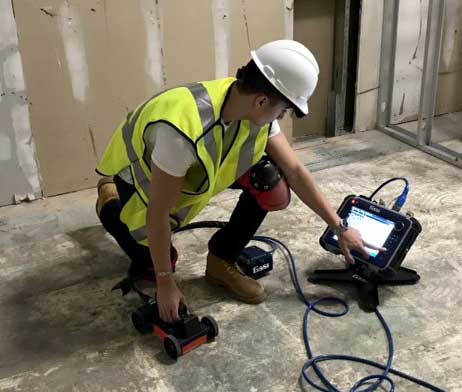Why Select RainierGPR Concrete Scanning for Accurate Subsurface Analysis
Why Select RainierGPR Concrete Scanning for Accurate Subsurface Analysis
Blog Article
Exploring the Key Advantages of Concrete Scanning in Building And Construction Projects
In the world of contemporary building practices, the application of concrete scanning modern technology has become a crucial device for guaranteeing task performance and architectural integrity. From boosting security measures to properly detecting energies hidden under the surface, the benefits of concrete scanning are multifaceted. The capacity to improve project timelines and lower expenses while preserving existing frameworks is a testament to the worth this technology offers the construction sector. As we look into the nuanced advantages of concrete scanning, it ends up being evident that its effect expands much beyond surface-level analyses, using a peek into the intricate internet of advantages waiting to be revealed.
Improved Safety And Security Actions
Making use of advanced concrete scanning innovation boosts precaution on construction sites by giving accurate detection of prospective dangers concealed underneath the surface. This innovation allows building teams to determine rebar, channels, post-tension cords, and other obstructions before excavation or drilling, significantly reducing the danger of accidents. By pinpointing these aspects exactly, employees can avoid destructive essential architectural parts, therefore avoiding injuries, hold-ups, and expensive repair work.
Moreover, concrete scanning plays an essential function in ensuring the honesty of existing structures during improvements or growths. By identifying weaknesses, voids, or damage within concrete aspects, engineers can attend to these issues proactively, boosting the general safety and security and durability of the building. This positive approach not just reduces the threat of structural failings however additionally reduces the potential for mishaps triggered by unanticipated structural deficiencies.
Fundamentally, the implementation of concrete scanning modern technology functions as an aggressive precaution that safeguards both construction workers and the architectural integrity of buildings, eventually adding to the general success and efficiency of building tasks. - RainierGPR Concrete Scanning
Accurate Detection of Utilities
Concrete scanning modern technology helps with specific identification of below ground energies, enhancing building website safety and efficiency. Precise discovery of energies is important in building and construction tasks to avoid pricey problems, project delays, and most significantly, ensure the safety of employees and the general public. By making use of advanced scanning technologies such as ground-penetrating radar (GPR) and electro-magnetic induction, building and construction groups can map out the place of hidden pipelines, wires, and other utilities with high levels of accuracy.

Time and Cost Efficiency

Concrete scanning technology enables building groups to accurately find rebar, post-tension cords, and various other embedded items within concrete frameworks. This precise info assists in staying clear of pricey mistakes such as unintentional damages to critical aspects throughout exploration, reducing, or coring activities. In addition, by recognizing possible risks beforehand, the demand learn this here now for costly fixings or remodel because of problems can be lessened, bring about cost financial savings for the project.
Moreover, the capacity to promptly and properly detect energies under the surface without triggering any type of damage not just conserves time yet likewise prevents expensive disturbances to existing infrastructure. Overall, the time and price performance advantages of concrete scanning make it an invaluable tool for boosting building and construction job administration and execution.
Preservation of Architectural Stability
Protecting the structural honesty of structures and facilities is critical in ensuring long-term security and security. Concrete scanning plays an important role in this conservation process by allowing building and construction experts to identify possible dangers to the structural honesty of a building or infrastructure prior to they intensify right into major issues. Via using advanced scanning modern technologies such as ground-penetrating radar (GPR) and electromagnetic induction, building and construction groups can non-invasively assess the problem of concrete structures, locate rebar, post-tension cords, and other embedded components, and determine any kind of spaces, cracks, or degeneration within the concrete.
Improved Task Planning
In order to make certain the effective implementation of construction tasks, thorough interest to information and complete preparation are necessary elements that stem from a comprehensive understanding of the architectural conditions identified with concrete scanning. Eventually, including concrete scanning into the job planning stage enhances sychronisation amongst team members, cultivates aggressive problem-solving, and adds to the successful delivery of building and construction tasks within spending plan and schedule constraints.
Conclusion
In final thought, concrete scanning uses countless benefits in construction tasks. By improving precaution, accurately detecting utilities, boosting time and cost effectiveness, maintaining structural integrity, and helping in task planning, concrete scanning confirms visite site to be an important device for effective project implementation. Its ability to alleviate risks, boost efficiency, and make sure task honesty makes it an essential property for building specialists.
In the world of modern building and construction practices, the usage of concrete scanning modern technology has arised as a critical device for ensuring project effectiveness and architectural honesty.Concrete scanning technology allows building groups to accurately find rebar, post-tension cords, and various other ingrained objects within concrete structures. With the use of innovative scanning technologies such as ground-penetrating radar (GPR) and electromagnetic induction, building teams can non-invasively examine the problem of concrete frameworks, situate rebar, post-tension wires, and various other embedded elements, and recognize any voids, cracks, or degeneration within the concrete.
In order to make sure the effective implementation of building and construction tasks, precise attention to detail and comprehensive preparation are vital elements that stem from an extensive understanding of the architectural problems identified via concrete scanning. Eventually, integrating concrete scanning into the project preparation phase enhances coordination amongst group members, promotes positive problem-solving, and contributes to the successful distribution of building and construction tasks within budget plan and routine constraints.
Report this page